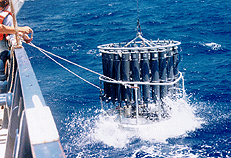How can we best use observations and models to quantify the state of the Earth System and better understand the coupled interactions between the ocean, atmosphere, cryosphere and biosphere? This complex but vital question was at the heart of the second ESA Summer School on Earth System Monitoring & Modelling.
This summer, 68 young scientists coming from 21 countries across the world (e.g. Europe, Canada, Australia, Argentine, Brazil, China, India) converged on ESA’s European Sp
A new Envisat viewing mode means that icebergs can be routinely tracked on their long trek around Antarctica, with regularly updated images of polar regions now available to highlight ice movements.
The Advanced Synthetic Aperture Radar (ASAR) instrument on ESA’s Envisat can see through the polar storms and winter darkness that keep Antarctica hidden from optical satellite sensors. ASAR works in a variety of different modes: its latest, operational since February, is called Glo
A few NASA satellites designed to study heights of Earth’s ocean surfaces are now also coming in handy for tracking water levels of inland lakes and reservoirs.
When analysts at the United States Department of Agriculture (USDA) Foreign Agriculture Service (FAS) learned that NASA satellites could be used for measuring lake water heights, they saw a chance to get vital information for managing irrigation and forecasting crop production in out-of-the way places.
Since early

Large, nutrient-poor expanses of the open ocean are getting a substantial nitrogen influx from an abundant group of unicellular organisms that “fix,” or chemically alter, nitrogen into a form usable for biological productivity.
First identified about five years ago, these organisms – about 7 microns in diameter – are fixing nitrogen at rates up to three times higher than previously reported for the Pacific Ocean, according to research published in the Aug. 26, 2004 edition of the jo
Over the past six weeks, scientists aboard the research vessel “Polarstern” of the Alfred Wegener Institute for Polar and Marine Research have been investigating changes in ocean temperature and sea ice cover in the area of Fram Strait between Spitsbergen and Greenland.
In this area significant exchange of water masses between the Arctic Ocean and the Atlantic Ocean takes place. The ongoing process of global warming throughout the past years has also altered conditions in Fram Stra
US saltwater recreational fishing catch rivals commercial fisheries for many depleted fish stocks including red snapper, black seabass, and lingcod
Taking a hard look at the common belief that recreational fishing accounts for only 2-3% of total landings in the U.S., a new study published in the journal Science (August 26th) reveals that recreational catches account for nearly a quarter of the total take of over fished populations, including many of the most economically valuable sp